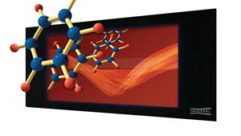
Top Classroom Technologies for 2008
Jan 2, 2008 12:00 PM,
By Linda Seid Frembes

HP CP-X205
As teachers and students get geared up for the second half of the school year to start, systems integrators are reviewing last year’s sales figures and predicting what may be top technologies for classrooms in the coming year. Bob Berry, a Seattle-based sales executive for AV supplier Troxell Communications shares his thoughts on the top tech for 2008.
Projectors
“We are seeing a growing need for ceiling-mounted installed projectors in the majority of K-12 classrooms,” he says. According to Berry, the most popular model is the Hitachi CP-X205 2200-lumen XGA LCD networkable projector. “Networking the projectors is also a very popular application. School administrators can send out network-wide messages to each classroom like emergency alerts or severe weather advisories.”
Networking also allows for cost savings using a global scheduled on/off for all networked projectors. “Using network functionality, you can monitor, control, and secure the equipment from a remote location. Unfortunately, theft is sometimes an issue, and you can set the system to send an automatic email alert if the projector is disconnected,” Berry says.
A recent innovation in projector technology is the Hitachi CP-A100 3LCD projector that features a very short throw distance of 60in. at 1.4ft.—thus eliminating the problem an obstructed image by the presenter. The CP-A100 also offers networking capability and can be installed vertically, horizontally, or inverted for ceiling mount applications.
The CP-A100 offers 2500 ANSI lumens, XGA resolution, and a 400:1 contrast ratio, and it addresses the issue of security with functions such as multilevel PIN locks, a security bar, and a Kensington slot.
Hitachi provides more control functions via its Projector Management Software (PJMan) and PJCtrl projector software, which gives projector control to the PC (akin to a remote control) via a desktop toolbar.

AVerMedia AVerVision SPC300
Document Cameras
Document cameras, also known as visualizers or digital presenters, are taking the space once held for the overhead projector. Today’s document cameras from manufacturers such as AverMedia, Elmo, and Lumens, among others, provide functionality above and beyond anything that an overhead projector can do.
“The current trend for this equipment is to download software to increase functionality,” Berry says. “Software from the manufacturer allows the teacher to annotate over the image or object. There are unique uses like the ability to capture video or audio and post to the web.” Current models are portable, digital, versatile, and easy to use.
And because document cameras can also handle 3D objects in addition to 2D documents, the applications are not limited to one type of school subject—be it science, English, history, or math.
Interactive Whiteboards
Interactive whiteboards have dominated the classroom for the past few years. Their popularity in both K-12 and higher education has meant widespread adoption. “The next generation of whiteboards offer advanced functionality like multitouch, where two users can enter data at the same time like the Hitachi StarBoard FX-77 Duo,” Berry says.
The StarBoard FX-77 Duo offers increased interactivity and control by responding to multi-touch gestures using a finger, optional electronic pen, or any object. Teachers are encouraged to have two students working at the same time.
The Duo also features an electronic-free surface and 24 customizable side buttons, and it can be used as a regular whiteboard.

Phonic Ear FrontRow To Go
Soundfield Systems
For years, research studies have touted the benefits of amplified speech systems in the classroom. School districts are starting to react to the positive benefits by installing soundfield systems, especially in K-12 classrooms. Berry says that one popular brand is the FrontRow by Phonic Ear infrared (IR) amplified speech system, which is currently being installed in every elementary classroom in the Seattle school district.
The basic system includes four installed loudspeakers (ceiling-mount or wall-mount depending on the classroom infrastructure), a dome sensor, a pendant microphone for the teacher, and an IR receiver. Troxell adds a pass-around microphone for the students.
The company offers three types of systems for the classroom. The FrontRow To Go is a portable FM soundfield system with two speakers housed in one unit; the FrontRow Tempo is a wireless FM soundfield system with four wall or ceiling speakers; and finally the FrontRow Pro Digital is a wireless infrared sound field system ideal for schools amplifying multiple classrooms using infrared light.
Classroom Response Systems
As a leading-edge technology, classroom response systems are slowly making their way into classrooms. Berry says a popular system is the Renaissance Learning 2Know! classroom response system. According to the manufacturer, each 2Know! classroom response system includes Renaissance Responders, AccelTest software, the 2Know! Toolbar, content, gradebook, carrying case, and remote online training.
Teachers can use classroom response systems for a variety of applications, from informal polling of the students to administering pop quizzes and checking to see if students understood the lesson before moving forward.








